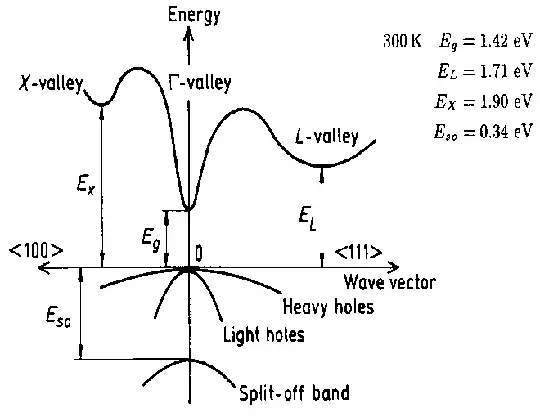To summarize, I found this phenomenon to be pretty well explained by Fang et. al. in 1. I will relate more information from a few sources here.
In the Hamiltonian for the holes in the valence bands of III–V compound semiconductors, there is a strong spin-orbit coupling between the crystal momentum and hole angular momentum. The atomic $J = 3/2$ states have a four-fold degeneracy (see 1 for details on why), and this degeneracy is further split into two doubly degenerate bands by the crystal-hole momentum coupling. The higher valence bands are denoted "heavy" and the lower are denoted "light". The splitting between the heavy and light bands is comparable to the kinetic energy from the Hamiltonian describing them - the Luttinger Hamiltonian. Technically, the splitting is determined by these Luttinger parameters ($\gamma$).
$$ H_{L} \left(\mathbf{k} \right) = - \left( \gamma_{1} + \frac{5}{2} \gamma_{2} \right) \frac{\hbar^{2} \mathbf{k}^{2}}{2 m_{0}} + \gamma_{2} \frac{\hbar^{2}}{2 m_{0}} \left( k_{x}^{2} J_{x}^{2} + k_{y}^{2} J_{y}^{2} + k_{z}^{2} J_{z}^{2} \right) + \gamma_{3} \frac{\hbar^{2}}{2 m_{0}} \left( \left\{ k_{x}, k_{y} \right\} \left\{ J_{x}, J_{y} \right\} + c.p.\right)$$
Here, $\left\{ J_{i} \right\}$ are spin-$3/2$ matrices, $\gamma$ are so-called Luttinger parameters, $m_{0}$ the bare electron mass, $\left\{ A, B \right\} = \frac{AB + BA}{2}$, c.p. terms for the cyclic permutations of $x$, $y$, $z$.
In terms of what why we can see this splitting (more concretely), [2] gives an example where the heavy and light hole splitting in a group-IV quantum dot is given by the perpendicular confinement of the quantum dot. In this example, the diagonal terms of the barrier configuration change the heavy hole - light hole splitting by a constant.
In examples like this, you can think of the quantum dot as approximating a 3D quantum particle in a box. The vertical confinement in [2] is achieved by a gate electric field in the "growth" direction - the literal direction in which a Germanium trace is grown on a substrate in the lab. The lateral confinement is modeled by an in-plane parabolic potential well.
In terms of why we see this (more generally), I need to refer myself to [3] and [4] for group theoretic details, which are now on my reading list.
Fang, Y., Philippopoulos, P., Culcer, D., Coish, W. A., & Chesi, S. (2023). Recent advances in Hole-spin qubits. Materials for Quantum Technology, 3(1), 012003. https://doi.org/10.1088/2633-4356/acb87e
Wang, Z., Marcellina, E., Hamilton, A. R., Cullen, J. H., Rogge, S., Salfi, J., & Culcer, D. (2021). Optimal Operation Points for ultrafast, highly coherent GE hole spin-orbit qubits. Npj Quantum Information, 7(1). https://doi.org/10.1038/s41534-021-00386-2
Elliott, R. J. (1964). The properties of the thirty-Two point groups. Cryogenics, 4(5), 334. https://doi.org/10.1016/0011-2275(64)90116-x
Dresselhaus, M. S., Dresselhaus, G., & Jorio, A. (2010). Group theory: Application to the physics of Condensed Matter. Springer-Verlag.
